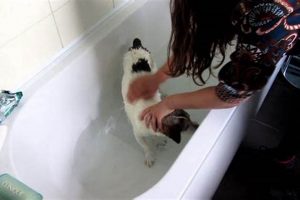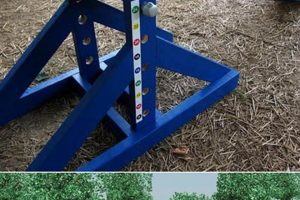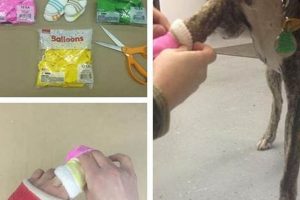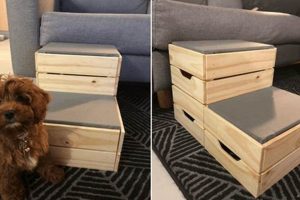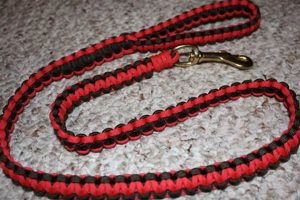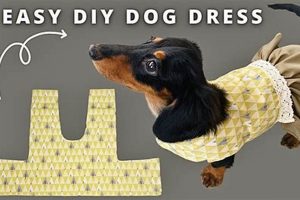Creating canine sleeping quarters through do-it-yourself methods involves the construction of beds for dogs utilizing readily available materials and personal craftsmanship. This process allows for customization of size, shape, and material selection to suit individual canine needs and owner preferences. For example, a repurposed sweater filled with stuffing can become a comfortable, circular bed for a small breed.
The value of constructing pet beds in this manner extends beyond mere cost savings. It offers a sustainable alternative to commercially produced items, frequently utilizing recycled or repurposed resources. Furthermore, the practice allows owners to create a sleeping space perfectly tailored to their dog’s specific physical requirements and behavioral tendencies. Historically, homemade pet beds have been a common practice, reflecting resourcefulness and a personalized approach to animal care.
This article will explore various approaches to this construction, including material selection considerations, step-by-step construction guides, and design ideas for crafting suitable and durable resting places for canine companions. Attention will be given to safety and hygiene aspects to ensure a comfortable and healthy environment for the animal.
Construction Recommendations
The following recommendations aim to provide guidance in the creation of durable and suitable canine sleeping areas. Adherence to these suggestions can promote both the longevity of the constructed item and the comfort of the animal.
Tip 1: Material Selection: Choose fabrics resistant to wear and tear, such as canvas or denim. Opt for fillings that retain their form and are easily washable, such as shredded memory foam or polyester fiberfill. Avoid materials that may pose a choking hazard if ingested.
Tip 2: Dimensional Accuracy: Measure the dog in a sleeping position to determine optimal bed size. Add several inches to these measurements to ensure adequate space for movement and adjustment. Consider the breed and expected growth rate if constructing a bed for a puppy.
Tip 3: Seam Reinforcement: Utilize reinforced stitching techniques, such as backstitching or double stitching, at all seams to prevent premature ripping or unraveling. Pay particular attention to areas that are subject to significant stress, such as corners and edges.
Tip 4: Allergen Considerations: Select hypoallergenic materials and ensure the bed is washable to minimize the accumulation of allergens, such as dust mites and pet dander. Regular cleaning is essential for maintaining a healthy sleeping environment.
Tip 5: Waterproofing Strategies: Incorporate a waterproof lining or base layer to protect the filling from moisture damage due to spills or accidents. This can be achieved using laminated fabrics or plastic sheeting. Ensure the waterproof layer is concealed and does not compromise comfort.
Tip 6: Safety Inspection: Regularly inspect the constructed bed for any signs of damage, such as loose threads, exposed zippers, or weakened seams. Repair any damage promptly to prevent potential hazards to the animal.
By following these recommendations, it is possible to create a comfortable and durable resting place that meets the specific needs of the animal while minimizing potential safety and health risks.
The subsequent section will discuss advanced design techniques and customization options for enhancing the functionality and aesthetic appeal of the finished product.
1. Size appropriateness
The determination of correct dimensions constitutes a fundamental aspect within the do-it-yourself construction of canine beds. Appropriately sized resting spaces are essential for promoting optimal canine comfort, supporting musculoskeletal health, and facilitating natural sleep behaviors.
- Accurate Measurement Techniques
Employing precise measurement techniques is critical in determining the required bed dimensions. This necessitates measuring the dog’s length in a fully stretched position and its width in a curled sleeping posture. An allowance should be added to these measurements to ensure sufficient space for movement and adjustment within the bed.
- Breed-Specific Considerations
Variations in breed characteristics, such as body length, weight, and sleeping habits, necessitate tailored size considerations. Smaller breeds require proportionally smaller beds, while larger breeds demand more substantial dimensions to accommodate their size and weight. Ignoring breed-specific requirements can result in discomfort or inadequate support.
- Developmental Stages
When constructing a bed for a puppy, it is crucial to consider future growth. Selecting a size that accommodates anticipated adult dimensions prevents the need for frequent replacements. Alternatively, a modular design can allow for size adjustments as the puppy matures.
- Impact on Joint Health
Inadequate bed size can negatively impact canine joint health, particularly in older or arthritic animals. A bed that is too small may force the dog into unnatural sleeping positions, exacerbating existing joint pain or contributing to the development of new musculoskeletal issues. Adequate size is crucial for providing proper support and promoting healthy joint alignment.
Ultimately, accurate measurement, breed-specific knowledge, consideration of developmental stages, and awareness of the impact on joint health all converge to underscore the importance of size appropriateness in the do-it-yourself construction of canine beds. A well-sized bed contributes significantly to the animal’s comfort, health, and overall well-being, thereby enhancing the value and effectiveness of the endeavor.
2. Material durability
The selection of resilient materials constitutes a critical factor in the do-it-yourself construction of canine beds. Material durability directly influences the lifespan of the bed, its resistance to damage from canine activity, and the overall cost-effectiveness of the construction project.
- Fabric Resistance to Abrasion
The chosen fabric must withstand constant friction from the dog’s movements, scratching, and general use. Durable fabrics such as canvas, denim, or tightly woven upholstery materials provide superior abrasion resistance compared to lighter-weight or loosely woven alternatives. The selection directly impacts the bed’s longevity and resistance to wear and tear.
- Seam Strength and Integrity
Seams represent vulnerable points in the bed’s construction. Utilizing strong thread and employing reinforced stitching techniques are essential for maintaining seam integrity under stress. Weak seams are prone to tearing or unraveling, leading to premature bed failure and potential hazards for the animal.
- Resistance to Moisture and Degradation
Canine beds are susceptible to moisture exposure from spills, accidents, or outdoor use. Materials with inherent water resistance or the application of waterproof coatings can prevent moisture penetration and subsequent degradation of the filling materials. This resistance is crucial for maintaining hygiene and preventing mold or mildew growth.
- Filling Material Compression and Longevity
The selected filling material must retain its form and resilience over time to provide consistent support and comfort. High-density foam, shredded memory foam, or durable fiberfill options offer superior compression resistance compared to less resilient alternatives such as cotton batting or loosely packed stuffing. The filling’s longevity directly impacts the bed’s long-term comfort and support.
The interplay between fabric abrasion resistance, seam integrity, moisture resistance, and filling material longevity collectively determines the overall durability of a do-it-yourself canine bed. Prioritizing material selection based on these factors ensures a longer-lasting, more cost-effective, and ultimately more satisfactory outcome for both the owner and the animal.
3. Comfort features
The incorporation of comfort features within do-it-yourself canine bed construction represents a critical element directly influencing the bed’s acceptance and utilization by the animal. These features address the tactile, thermal, and postural needs of the dog, translating directly into improved rest quality and overall well-being. Ineffective comfort features, conversely, render the bed undesirable, negating the effort invested in its construction. For instance, a bed constructed from rough, scratchy material may be rejected outright, despite its appropriate size and structural integrity. Therefore, the judicious selection and implementation of such features are paramount to successful bed creation.
Specific comfort features include considerations for appropriate cushioning through filling material choices. High-density memory foam can contour to the dog’s body, providing support and pressure relief, which is particularly beneficial for older animals or those with joint problems. Thermal regulation is also key; breathable fabrics prevent overheating, while insulated bases offer warmth in colder environments. Design elements like raised edges can provide a sense of security, mimicking the feeling of a den, leading to more relaxed sleep. The practical application of these principles requires careful observation of the dog’s preferred sleeping positions and microclimate preferences.
In summary, comfort features within do-it-yourself dog beds are not mere additions but essential components directly tied to the bed’s usability and positive impact on the animal. The strategic selection and implementation of appropriate comfort features address fundamental canine needs, fostering restful sleep and improved well-being. Failure to adequately address these needs results in an underutilized bed and a missed opportunity to enhance the dog’s quality of life. Thus, a deep understanding of canine comfort requirements should be foundational to any do-it-yourself bed project.
4. Safety precautions
The integration of stringent safety precautions into do-it-yourself canine bed construction is paramount due to the potential for unintended harm stemming from inappropriate materials or construction techniques. Neglecting these precautions can lead to a range of adverse consequences for the animal, including toxic exposure, choking hazards, and physical injury. For example, the use of treated wood or fabrics containing formaldehyde, while potentially cost-effective, can release harmful chemicals that the dog may ingest or inhale, leading to chronic health problems. Similarly, small, detachable components, such as buttons or loosely attached decorative elements, present a choking risk if ingested.
The selection of non-toxic materials is therefore essential. Organic cotton, hypoallergenic fillings, and water-based finishes represent safer alternatives to conventional materials. Furthermore, durable construction methods, such as reinforced stitching and the secure attachment of all components, minimize the risk of disintegration and the creation of hazardous loose parts. A real-world example involves a case where a dog ingested stuffing from a poorly constructed bed, requiring emergency veterinary intervention. This illustrates the practical significance of meticulous construction and the selection of appropriate materials. Regularly inspecting the finished bed for signs of wear and tear, such as frayed seams or exposed filling, is a proactive measure to mitigate potential risks.
In conclusion, safety precautions are not merely ancillary considerations in do-it-yourself canine bed projects; they are integral components that directly impact the animal’s well-being. The challenges associated with identifying and mitigating potential hazards underscore the need for thorough research and careful execution. Prioritizing safety ensures that the constructed bed provides a secure and comfortable resting place, rather than a source of potential harm. This approach aligns with the broader theme of responsible pet ownership and contributes to the animal’s overall quality of life.
5. Washability/hygiene
The implementation of effective cleaning protocols and hygienic material choices constitutes a critical aspect of do-it-yourself canine bed construction. The maintenance of a clean sleeping environment directly impacts the animal’s health, minimizing exposure to allergens, parasites, and pathogens. Failure to prioritize washability and hygiene can result in dermatological issues, respiratory problems, and the proliferation of undesirable odors.
- Material Selection for Easy Cleaning
The selection of fabrics and fillings that are readily washable and quick-drying is paramount. Durable, machine-washable materials, such as canvas or tightly woven synthetics, facilitate regular cleaning. Avoid materials that are prone to shrinkage, fading, or degradation upon washing. Examples of suitable fillings include shredded memory foam or polyester fiberfill, which can be easily laundered and dried. In contrast, materials like cedar chips or untreated down feathers pose significant cleaning challenges and are therefore less suitable.
- Design Considerations for Accessibility
The design of the bed should incorporate features that enhance accessibility for cleaning. Removable covers, zippered compartments, and segmented filling inserts simplify the process of disassembling and laundering the bed components. A design that allows for easy access to all interior surfaces facilitates thorough cleaning and reduces the risk of harboring allergens or parasites. Integrating a waterproof lining beneath the outer cover protects the filling from moisture damage and simplifies spot cleaning.
- Regular Cleaning Schedules and Procedures
Establishing a consistent cleaning schedule is crucial for maintaining a hygienic sleeping environment. The frequency of cleaning depends on factors such as the dog’s shedding habits, outdoor activity levels, and the presence of allergies. At a minimum, the bed cover should be washed weekly, and the filling should be laundered or replaced periodically. Vacuuming the bed regularly helps remove loose hair, dirt, and debris. Employing appropriate cleaning agents that are safe for animals is essential to prevent irritation or allergic reactions.
- Antimicrobial Treatments and Fabrics
The incorporation of antimicrobial treatments or the use of fabrics with inherent antimicrobial properties can further enhance hygiene. These treatments inhibit the growth of bacteria, fungi, and other microorganisms that contribute to odor and potential health problems. However, it is essential to select antimicrobial agents that are non-toxic and safe for prolonged contact with the animal. Silver-infused fabrics and enzyme-based cleaning products represent examples of potentially beneficial antimicrobial strategies.
In conclusion, washability and hygiene represent integral design and maintenance considerations in the do-it-yourself construction of canine beds. The selection of appropriate materials, implementation of accessible designs, adherence to regular cleaning schedules, and incorporation of antimicrobial strategies collectively contribute to a healthier and more comfortable sleeping environment for the animal. Neglecting these aspects can compromise the bed’s longevity, diminish its hygienic properties, and potentially impact the dog’s well-being.
Frequently Asked Questions
The following addresses common inquiries and concerns regarding the construction of sleeping accommodations for canines via do-it-yourself methods. Clarity on these points can enhance the success and safety of such projects.
Question 1: What is the optimal filling material for a canine bed designed for an animal with arthritis?
Shredded memory foam or orthopedic foam provides superior support and pressure relief for canines suffering from arthritis. These materials conform to the animal’s body, reducing stress on joints. Standard fiberfill offers inadequate support for arthritic conditions.
Question 2: How frequently should a do-it-yourself canine bed be laundered?
A canine bed should be laundered at least bi-weekly, or more frequently if the animal spends significant time outdoors or exhibits shedding. Regular washing mitigates the accumulation of allergens, parasites, and unpleasant odors.
Question 3: What fabric types are most resistant to damage from canine chewing behavior?
Heavy-duty canvas, denim, or ripstop nylon exhibit superior resistance to tearing and damage from canine chewing. Loosely woven or delicate fabrics should be avoided due to their vulnerability to destruction.
Question 4: Is it necessary to incorporate a waterproof barrier into a do-it-yourself canine bed?
The inclusion of a waterproof barrier is highly recommended, particularly for animals prone to accidents or those who spend time outdoors. A waterproof layer protects the filling material from moisture damage and simplifies cleaning.
Question 5: What safety precautions should be observed when selecting filling materials?
Filling materials should be non-toxic, hypoallergenic, and free from small parts that could present a choking hazard. Avoid materials treated with flame retardants or other potentially harmful chemicals.
Question 6: How does bed size influence the animal’s comfort and well-being?
An inadequately sized bed restricts the animal’s ability to stretch and move freely, potentially leading to discomfort and musculoskeletal issues. The bed should be sufficiently large to accommodate the animal’s fully extended length and width.
Proper planning and execution, mindful of the issues addressed here, leads to more comfortable and lasting dog beds.
The subsequent discussion focuses on common designs and variations of the subject.
Dog Bed DIY
The preceding discourse has detailed critical facets of canine bed construction through do-it-yourself methodologies. Key considerations encompass material selection, dimensional accuracy, structural integrity, and hygienic maintenance. The information presented serves to equip individuals with the knowledge necessary to create safe, comfortable, and durable sleeping environments for their canine companions.
Successful application of these principles necessitates a thorough understanding of canine needs and responsible execution. The creation of a dog bed represents a commitment to animal well-being. Continued innovation in materials and designs promises further enhancement of canine comfort and long-term health. Diligence and informed decision-making remain paramount to achieving positive outcomes in this endeavor.


